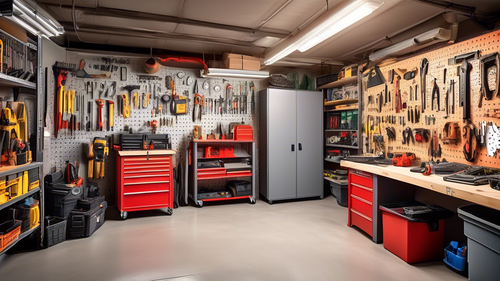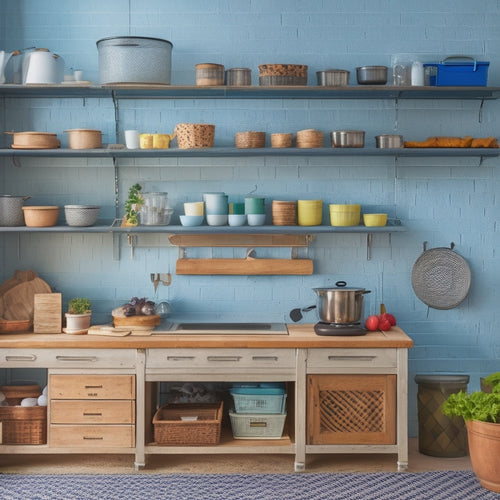
Organize Your Pantry With Storage Bins Solutions
Share
You're about to convert your pantry into a model of efficiency and functionality by utilizing the power of storage bins to maximize storage, minimize clutter, and streamline meal prep. Start by evaluating your pantry's storage needs, identifying frequently used items, and measuring your shelves and corners for the right bin sizes. Choose bins that fit your pantry style, and consider functionality features like stackability and handles. Maximize vertical storage space by stacking shelves, reserving upper shelves for lighter items, and labeling each shelf. Now, get ready to take your pantry organization to the next level with more expert solutions and customized storage strategies.
Key Takeaways
- Assess pantry storage needs by conducting an inventory, identifying frequently used items, and evaluating living space functionality.
- Choose storage bins that fit pantry style, with sizes and shapes suitable for various items, and consider functionality features like stackability.
- Maximize vertical storage space by stacking shelves, placing heavier items on lower shelves, and reserving upper shelves for lighter items.
- Utilize corner storage effectively by installing corner shelves, using lazy susans, and incorporating baskets or bins for dry goods.
- Label each storage bin and shelf for quick identification, implementing a color-coding system and adding "use by" dates to perishable items.
Assessing Your Pantry Storage Needs
Before you start organizing your pantry with storage bins, take stock of what you're working with: walk into your pantry and take a good hard look around.
Make a pantry inventory by noting what you have, how much of it you have, and where it's currently stored. Identify the items you use most frequently and those that are expired or no longer needed.
To guarantee a more efficient pantry organization, consider evaluating your living spaces for functionality and optimizing your storage layout.
Next, assess your storage space: measure the shelves, cabinets, and corners, and think about how you can optimize them.
Consider the types of items you need to store, such as dry goods, canned goods, or snacks, and how you can group them logically.
This storage assessment will help you determine the right number and size of storage bins you need to get your pantry organized and functional.
Choosing the Right Storage Bins
How do you determine the perfect storage bins for your pantry? The key is to reflect on several factors that cater to your specific needs.
You'll want to think about:
-
The type of bin materials that fit your pantry's style, such as plastic, wood, or metal
-
Bin sizes that accommodate the items you need to store, from small spices to large cooking utensils
-
Bin colors that match your pantry's aesthetic or provide a pop of contrast
-
Bin shapes that fit snugly in corners or against walls
-
Bin functionality, such as stackability, portability, or built-in handles, that enhance your storage experience
Maximizing Vertical Storage Space
You can greatly increase your pantry's storage capacity by making the most of its vertical space.
To do this, you'll want to stack your shelves wisely, ensuring that the items you use most frequently are easily accessible.
Stack Shelves Wisely
Since you're working with a fixed amount of floor space, maximizing your pantry's vertical storage capacity is essential. To make the most of your shelves, you need to stack them wisely. This involves creating a shelf arrangement that allows you to store items of similar sizes and frequencies of use together.
Here are some tips to keep in mind:
-
Place heavier items, like stackable bins filled with grains or canned goods, on lower shelves for easy access and to prevent them from falling.
-
Reserve upper shelves for lighter, less frequently used items, such as special occasion dishes or infrequently used cookbooks.
-
Keep similar items, like baking supplies or snacks, grouped together on the same shelf.
-
Leave enough space between shelves for easy retrieval and to prevent clutter from building up.
-
Label each shelf so you can quickly identify what's stored there.
Utilize Wall Space
Now that you've optimized your shelf arrangement, it's time to turn your attention to the often-wasted space on your pantry walls. You can employ this vertical space with shelf brackets that hold wall-mounted containers or decorative baskets.
Hang organizers, like magnetic spice racks or pegboard solutions, to store frequently used items within easy reach. Install vertical dividers to separate items and keep them organized.
Use tension rods to hang items like aprons, oven mitts, or even snacks. By maximizing your pantry's vertical storage space, you'll free up floor and shelf space, making it easier to find what you need when you need it.
Take control of your pantry's layout and create a more efficient cooking experience.
Utilizing Corner Storage Effectively
When you're organizing your pantry, don't let corner space go to waste.
You'll want to maximize this area by using storage bins that fit snugly into the corner, allowing you to store more items without taking up precious floor or shelf space.
Maximize Corner Space
Your pantry's corner space is often the most underutilized area, but with the right storage solutions, it can become a precious asset.
By maximizing this space, you'll be able to store more items and keep your pantry organized. Here are some ways to do it:
-
Install corner shelves to store infrequently used items, such as special occasion dishes or cookbooks.
-
Use a lazy susan to store spices, oils, or condiments, making them easily accessible.
-
Invest in a corner carousel to store canned goods or snacks.
-
Add a basket or bin to store dry goods, like pasta or rice.
-
Consider a slide-out drawer to store heavy items, like pots and pans.
Accessibility Matters Most
By incorporating corner storage solutions, you've taken the first step towards a more organized pantry.
Now, it's vital to guarantee that the items you store in those corners are easily accessible. You want to maximize pantry accessibility, so you can quickly find what you need without having to dig through everything.
Installing pull-out baskets or shelves can make a huge difference. They allow you to see what's inside without having to reach deep into the corner. This storage efficiency hack will save you time and reduce frustration.
Labeling and Signage Best Practices
Sort through the clutter and get a handle on your pantry's organization by tackling the labeling and signage aspect.
You'll be amazed at how a little labeling can go a long way in maintaining your newly organized pantry.
-
Use clear fonts that are easy to read, even from a distance.
-
Implement a color-coding system to categorize similar items, such as baking supplies or snacks.
-
Label each storage bin and shelf so you can quickly identify what's inside.
-
Consider adding a "use by" date to perishable items to guarantee you consume them before they expire.
-
Make certain labels are consistent regarding font, size, and style to create a visually appealing and organized look.
Maintaining Pantry Organization Systems
Order prevails when you establish a routine to maintain your pantry's organization systems. Set aside time each week to tidy up and guarantee everything is in its designated bin.
Implement pantry maintenance tips, such as checking expiration dates, wiping down shelves, and restocking essentials. Develop organization routines that work for you, like designating a specific day for meal planning and grocery shopping.
This will help you stay on top of your pantry's contents and prevent clutter from building up again. By committing to regular maintenance, you'll enjoy the long-term benefits of a well-organized pantry, including reduced stress and saved time.
Customizing for Unique Storage Needs
Into the nooks and crannies of your pantry, storage bins can be customized to fit unique storage needs. You can create a personalized system that maximizes space and efficiency.
-
Use specialized containers for items like spices, oils, or condiments that require specific storage conditions.
-
Designate bins for snacks, baking supplies, or international ingredients to keep similar items together.
-
Employ stackable bins to store heavy or bulky items like canned goods or cooking utensils.
-
Incorporate baskets or woven bins for storing fresh produce or bread.
-
Label each bin to guarantee you can quickly find what you need, reducing meal prep time and stress.
Frequently Asked Questions
Can I Use Storage Bins With Wheels for Easier Pantry Access?
You're tired of rummaging through a pantry that's more chaotic than a raccoon's raid on a trash can. Yes, you can use storage bins with wheels for easier pantry access, bringing wheeled convenience to your pantry organization, and giving you the control you crave.
How Often Should I Clean and Sanitize My Pantry Storage Bins?
You should clean your storage bins every 1-2 months, and sanitize them every 3-4 months; wipe down bins with soap and warm water, then sanitize with a solution of 1 tablespoon unscented bleach per gallon of water.
Are Stackable Storage Bins Suitable for Heavy Pantry Items?
Will your stackable storage bins hold up to the weight? You're about to find out! Check the manufacturer's weight limitations to confirm your bins can handle heavy pantry items, and don't assume stackable means limitless strength - it's essential to know the limits!
Can I Mix and Match Different Storage Bin Sizes and Styles?
You can definitely mix and match different storage bin sizes and styles to achieve functional organization and a cohesive look, as long as you consider storage bin aesthetics, ensuring a visually appealing and harmonious pantry space that reflects your personal style.
Are Pantry Storage Bins Suitable for Storing Perishable Food Items?
When storing perishable food items, you'll want to prioritize food safety. Look for pantry storage bins with breathable materials, moisture-control features, and airtight seals to keep your food fresh and protected from spoilage.
Related Posts
-

Garage Organization 101
Garage Organization 101: The Ultimate Guide to a Tidy and Efficient Workspace Are you tired of stepping into your ...
-

Why You Need a Pro in Closet Design Online
You're tired of cluttered closets and wasted space. That's where a professional closet design expert comes in. They'l...
-

10 Budget-Friendly DIY Kitchen Space Hacks
You can release the full potential of your kitchen space without breaking the bank by incorporating creative, budget-...


